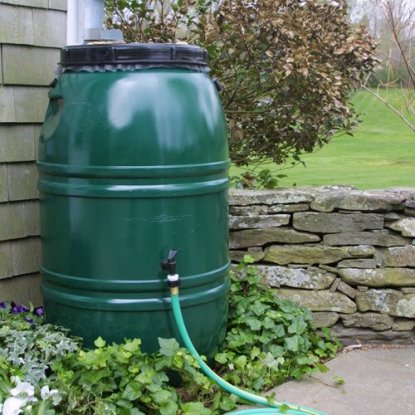
I really never understood the financial benefit of a rain collection system. To me it was always about stopping the erosion that always seemed to happen from my downspouts running off onto my grass. The more rain, the less grass remained, especially in the shaded areas.
I started to use a rain barrel at my house 2 years ago. Selection can be limited in stores so I purchased our first rain barrel through a website and have been very happy. It is made from recycled plastic but looks like an old wine barrel. It holds about 50 gallons of water which sometimes is not enough so last season I purchased another 2 rain barrels (same ones) and put one under another downspout. The second one was connected to the first rain barrel that I had in place from last year in a process called daisy chaining. The rain barrel has an overflow valve in the back that I connected a hose to the second barrel. When the first barrel is full the water overflows into the second rain barrel and not onto my grass. It works well.
To maximize the barrels performance you should purchase a soaker hose. These are hoses that let water seep through very slowly but keep the ground moist. Bury the hose under the mulch of your shrubs, winding the hose around the roots of the plants. Since rain barrel are all low pressure the water fills the soaker hose and slowly releases water at a constant rate. As long as there is water in the rain barrel the ground around the plants will stay wet and they plants will stay green.
Rain water collection is not very cost effective but it is good for the environment as well as a tool to help teach our next generation about conservation and erosion. Plus, the set-up is a nice little family project, especially with younger kids or grand kids. During the cooler months you want to make sure that the rain barrels are emptied to prevent freezing. The freezing of water in the rain barrels will cause cracking and leaking of water.
Samantha Michaels is an avid gardener and freelance writer.
Related Articles & Free Email Newsletter
Knowing When and How to Re-Pot a Plant




Comment here